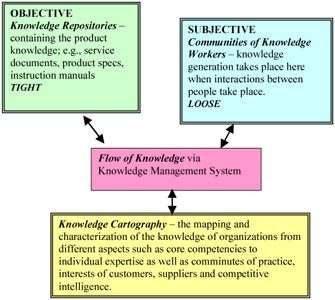Knowledge Architecture
|
Architecture, specifically the information technology architecture, is an integrated set of technical choices used to guide an organization in satisfying its business needs (Weil & Broadbent, 1998). Typical information technology architectures contain policies and guidelines covering hardware and software considerations, communications and network issues, guidelines pertaining to data usage and storage as well as applications and their functions. Similarly, the knowledge architecture outlines key aspects of knowledge including its form and how it is captured and transferred throughout the organization. Underlying the knowledge architecture (refer to Figure 16.2) is the recognition of the binary nature of knowledge, namely its objective and subjective components. What we realize when we analyze the knowledge architecture closely is that knowledge is not a clearly defined, easily identifiable phenomenon; instead, it has many forms which makes managing it even more challenging.
Knowledge can exist as an object in essentially two major forms: explicit or factual knowledge and tacit or "know how" (Polyani 1958, 1962). Explicit knowledge is highly refined knowledge consisting of descriptions of facts, concepts, judgments and relations between "knowledge chunks' that are recorded or established in books or papers (Wigg, 1993). Tacit knowledge, on the other hand, is complex, diffuse and mostly unrefined knowledge accumulated as know-how and understanding residing in people's heads (Wigg, 1993). It is well established that while both types of knowledge are important, tacit knowledge is more difficult to identify and thus manage (Nonaka & Takeuchi, 1995). Book knowledge or explicit knowledge by its very nature is passive while tacit knowledge, knowledge residing in people's heads, is active (Wigg, 1993). In addition, we have codified knowledge which is knowledge in computerized knowledge based systems (Wigg, 1993). All these manifestations of knowledge are forms of objective knowledge. Not only can objective knowledge take many forms but it can also be located at various levels; e.g., the individual, group or organization level (Hedlund, 1994). Of equal importance, though perhaps less well defined, knowledge also has a subjective component. When viewed from this perspective, knowledge is as an ongoing phenomenon being shaped by social practices of communities (Boland & Tenkasi, 1995) through activities such as brainstorming and discourse. The focus here is the creation of new knowledge through the generation and debate of divergent meanings (Wickramasinghe, 2002).

Figure 1: The Knowledge Architecture (Wickramasinghe & Mills, 2001).
The knowledge architecture then recognizes these two different yet key aspects of knowledge, namely knowledge as an object and a subject, and provides the blue prints for an all encompassing knowledge management system (KMS). Clearly, the knowledge architecture is defining a KMS that supports both objective and subjective attributes of knowledge. Thus, we have an interesting duality in knowledge management that some have called a contradiction (Schultz, 1998) and others describe as the loose-tight nature of knowledge management (Malhotra, 2000).
The pivotal function underlined by the knowledge architecture is the flow of knowledge. The flow of knowledge is fundamentally enabled (or not) by the knowledge management system.
|
EAN: 2147483647
Pages: 195
- A View on Knowledge Management: Utilizing a Balanced Scorecard Methodology for Analyzing Knowledge Metrics
- Measuring ROI in E-Commerce Applications: Analysis to Action
- Technical Issues Related to IT Governance Tactics: Product Metrics, Measurements and Process Control
- Governing Information Technology Through COBIT
- Governance Structures for IT in the Health Care Industry